
Majdanek
Encyclopedia
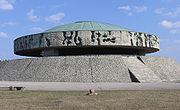
Majdanek was a German Nazi concentration camp on the outskirts of Lublin
Lublin
Lublin is the ninth largest city in Poland. It is the capital of Lublin Voivodeship with a population of 350,392 . Lublin is also the largest Polish city east of the Vistula river...
, Poland
Poland
Poland , officially the Republic of Poland , is a country in Central Europe bordered by Germany to the west; the Czech Republic and Slovakia to the south; Ukraine, Belarus and Lithuania to the east; and the Baltic Sea and Kaliningrad Oblast, a Russian exclave, to the north...
, established during the German Nazi occupation of Poland. The camp operated from October 1, 1941 until July 22, 1944, when it was captured nearly intact by the advancing Soviet Red Army
Red Army
The Workers' and Peasants' Red Army started out as the Soviet Union's revolutionary communist combat groups during the Russian Civil War of 1918-1922. It grew into the national army of the Soviet Union. By the 1930s the Red Army was among the largest armies in history.The "Red Army" name refers to...
. Although conceived as a forced labor
Unfree labour
Unfree labour includes all forms of slavery as well as all other related institutions .-Payment for unfree labour:If payment occurs, it may be in one or more of the following forms:...
camp and not as an extermination camp, over 79,000 people died there (59,000 of them Polish Jews) during the 34 months of its operation.
The name 'Majdanek' ("little Majdan") derives from the nearby Majdan Tatarski ("Tatar Maidan") district of Lublin, and was given to the camp in 1941 by the locals, who were aware of its existence. In Nazi documents, and for reasons related to its funding, Majdanek was initially "Prisoner of War Camp of the Waffen-SS
Waffen-SS
The Waffen-SS was a multi-ethnic and multi-national military force of the Third Reich. It constituted the armed wing of the Schutzstaffel or SS, an organ of the Nazi Party. The Waffen-SS saw action throughout World War II and grew from three regiments to over 38 divisions, and served alongside...
in Lublin". It was renamed "Konzentrationslager Lublin" (Concentration Camp Lublin) in February 1943.
Among German Nazi concentration camps, Majdanek was unusual in that it was located near a major city, not hidden away at a remote rural location. It is also notable as the best-preserved concentration camp of the Holocaust - there had been too little time for the Nazis to destroy the evidence before the Red Army arrived.
Construction
"Konzentrationslager Lublin" (Concentration Camp Lublin), the official name of the Majdanek concentration camp, was established in October 1941, on Heinrich HimmlerHeinrich Himmler
Heinrich Luitpold Himmler was Reichsführer of the SS, a military commander, and a leading member of the Nazi Party. As Chief of the German Police and the Minister of the Interior from 1943, Himmler oversaw all internal and external police and security forces, including the Gestapo...
's orders to Odilo Globocnik
Odilo Globocnik
Odilo Lotario Globocnik was a prominent Austrian Nazi and later an SS leader. He was an acquaintance of Adolf Eichmann, who played a major role in the extermination of Jews and others during the Holocaust...
, following the SS commander's visit to Lublin on 17 and 20 July 1941. Himmler's initial order was for a camp to hold "25,000 to 50,000" prisoners.
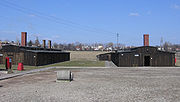
Battle of Kiev (1941)
The Battle of Kiev was the German name for the operation that resulted in a very large encirclement of Soviet troops in the vicinity of Kiev during World War II. It is considered the largest encirclement of troops in history. The operation ran from 23 August – 26 September 1941 as part of Operation...
, the number was subsequently raised to 50,000 and construction for that many began on October 1, 1941 (as it did also in Auschwitz-Birkenau, which had received the same order). In early November, the plans were then extended to 125,000, and in December to 150,000, and in March 1942 to 250,000 Soviet prisoners of war.
Construction began with 150 Jewish laborers from Globocnik's Lublin camp, where the laborers then returned each night. Later the workforce included 2,000 Red Army
Red Army
The Workers' and Peasants' Red Army started out as the Soviet Union's revolutionary communist combat groups during the Russian Civil War of 1918-1922. It grew into the national army of the Soviet Union. By the 1930s the Red Army was among the largest armies in history.The "Red Army" name refers to...
POWs, who however had to survive extreme conditions, including sleeping out in the open. By mid-November only 500 of them were still alive, of which at least 30% were incapable of further labor. In mid-December, barracks for only 20,000 were ready when a typhus
Typhus
Epidemic typhus is a form of typhus so named because the disease often causes epidemics following wars and natural disasters...
epidemic broke out, and by January 1942 all the forced laborers—POWs as well as Jews—were dead. All work ceased until March 1942, when new prisoners arrived. Although the camp did eventually have the capacity to hold approximately 50,000 prisoners, it did not grow significantly beyond that size.
In operation
In July 1942, Himmler visited BelzecBelzec extermination camp
Belzec, Polish spelling Bełżec , was the first of the Nazi German extermination camps created for implementing Operation Reinhard during the Holocaust...
, Sobibor
Sobibór extermination camp
Sobibor was a Nazi German extermination camp located on the outskirts of the town of Sobibór, Lublin Voivodeship of occupied Poland as part of Operation Reinhard; the official German name was SS-Sonderkommando Sobibor...
, and Treblinka, that is, the three camps built specifically for Operation Reinhard
Operation Reinhard
Operation Reinhard was the code name given to the Nazi plan to murder Polish Jews in the General Government, and marked the most deadly phase of the Holocaust, the use of extermination camps...
—the plan to eliminate Polish Jewry (cf. "Solution of the Jewish Question") in the five districts of occupied Poland that constituted the Nazi Generalgouvernement. Those camps had begun operations in respectively March, May and July of that year. Subsequently, Himmler issued an order that the deportation of Jews to the camps be completed by the end of 1942.
However, due to the need for Jewish manpower for the war effort, some laborers were temporarily spared, and were (for a time) either kept in the ghettos, such as the one in Warsaw
Warsaw Ghetto
The Warsaw Ghetto was the largest of all Jewish Ghettos in Nazi-occupied Europe during World War II. It was established in the Polish capital between October and November 15, 1940, in the territory of General Government of the German-occupied Poland, with over 400,000 Jews from the vicinity...
(which became a concentration camp after the Warsaw Ghetto Uprising
Warsaw Ghetto Uprising
The Warsaw Ghetto Uprising was the Jewish resistance that arose within the Warsaw Ghetto in German occupied Poland during World War II, and which opposed Nazi Germany's effort to transport the remaining ghetto population to Treblinka extermination camp....
), or sent to labor camps such as Majdanek where they worked primarily at the Steyr-Daimler-Puch
Steyr-Daimler-Puch
Steyr-Daimler-Puch was a large manufacturing conglomerate based in Steyr, Austria, which was broken up in stages between 1987 and 2001. The component parts and operations continued to exist under separate ownership and new names.-History:...
weapons/munitions factory.
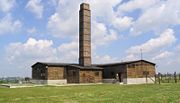
Belarusians
Belarusians ; are an East Slavic ethnic group who populate the majority of the Republic of Belarus. Introduced to the world as a new state in the early 1990s, the Republic of Belarus brought with it the notion of a re-emerging Belarusian ethnicity, drawn upon the lines of the Old Belarusian...
, Ukrainians
Ukrainians
Ukrainians are an East Slavic ethnic group native to Ukraine, which is the sixth-largest nation in Europe. The Constitution of Ukraine applies the term 'Ukrainians' to all its citizens...
, Russians
Russians
The Russian people are an East Slavic ethnic group native to Russia, speaking the Russian language and primarily living in Russia and neighboring countries....
, Germans
Germans
The Germans are a Germanic ethnic group native to Central Europe. The English term Germans has referred to the German-speaking population of the Holy Roman Empire since the Late Middle Ages....
, Austrians
Austrians
Austrians are a nation and ethnic group, consisting of the population of the Republic of Austria and its historical predecessor states who share a common Austrian culture and Austrian descent....
, Slovenes, Italians, and French
French people
The French are a nation that share a common French culture and speak the French language as a mother tongue. Historically, the French population are descended from peoples of Celtic, Latin and Germanic origin, and are today a mixture of several ethnic groups...
and Dutch
Dutch people
The Dutch people are an ethnic group native to the Netherlands. They share a common culture and speak the Dutch language. Dutch people and their descendants are found in migrant communities worldwide, notably in Suriname, Chile, Brazil, Canada, Australia, South Africa, New Zealand, and the United...
nationals. According to the data from the official Majdanek State Museum, 300,000 persons were inmates of the camp at one time or another. The prisoner population at any given time was much lower.
From October 1942 onwards, Majdanek also had female overseers, SS troopers who had been trained at the Ravensbrück concentration camp
Ravensbrück concentration camp
Ravensbrück was a notorious women's concentration camp during World War II, located in northern Germany, 90 km north of Berlin at a site near the village of Ravensbrück ....
. These women included Elsa Erich, Hermine Braunsteiner
Hermine Braunsteiner
Hermine Braunsteiner Ryan was a female camp guard and the first Nazi war criminal to be extradited from the United States.-Early life:...
, Hildegard Lächert
Hildegard Lachert
Hildegard Martha Lächert was a notorious female guard, Aufseherin, at several German World War II concentration camps. She became publicly known for her service at Ravensbrück, Majdanek and Auschwitz-Birkenau...
and Rosy Suess (or Süss).
Within the general framework of Operation Reinhard, Majdanek functioned as sorting and storage depot for property and valuables taken from the victims at the killing centers in Belzec, Sobibor, and Treblinka. Although Majdanek also occasionally functioned as a killing center for Jews, this was initially not as systematic as in the three specifically Operation Reinhard camps: Of the more than 2,000,000 Jews killed in the course of Operation Reinhard, 59,000 (of 78,000 altogether) were killed in Majdanek.
Majdanek did not initially have subcamps. These were incorporated in early autumn 1943 when the remaining forced labor camps around Lublin (Budzyn, Trawniki, Poniatowa, Krasnik, Pulawy, and the "Airstrip" and Lipowa camps) became sub-camps of Majdanek.
Operation Reinhard continued until early November 1943, when the last Generalgouvernement Jews were exterminated as part of Operation "Harvest festival". With respect to Majdanek, the most notorious of this wave of executions occurred on November 3, 1943 when 18,400 Jews were killed on a single day. On November 4, 25 Jews who had succeeded in hiding during the killings of the day before were found and executed. Another 611 prisoners, 311 women and 300 men, were commanded to sort through the clothes and remains of the dead. The men were at first commanded to bury the dead, but were later assigned to Sonderkommando 1005, where they had to exhume the same bodies for cremation. The men were then themselves executed. The 311 women were subsequently sent to Auschwitz where they were gassed. By the end of Operation "Harvest Festival," Majdanek had only 71 Jews left (out of a total of 6,562 prisoners).
Executions of the remaining prisoners continued at Majdanek in the months thereafter. Between December 1943 and March 1944, Majdanek received approximately 18,000 so-called "invalids," many of whom where subsequently gassed with Zyklon B
Zyklon B
Zyklon B was the trade name of a cyanide-based pesticide infamous for its use by Nazi Germany to kill human beings in gas chambers of extermination camps during the Holocaust. The "B" designation indicates one of two types of Zyklon...
(carbon monoxide
Carbon monoxide
Carbon monoxide , also called carbonous oxide, is a colorless, odorless, and tasteless gas that is slightly lighter than air. It is highly toxic to humans and animals in higher quantities, although it is also produced in normal animal metabolism in low quantities, and is thought to have some normal...
was used in the very early period). Executions by firing squad continued as well, with 600 shot on January 21, 1944, 180 shot on January 23, 1944, and 200 shot on March 24, 1944.
In late July 1944, with Soviet forces rapidly approached Lublin, the Germans hastily evacuated the camp. But the staff had only succeeded in partially destroying the crematoria before Soviet Red Army
Red Army
The Workers' and Peasants' Red Army started out as the Soviet Union's revolutionary communist combat groups during the Russian Civil War of 1918-1922. It grew into the national army of the Soviet Union. By the 1930s the Red Army was among the largest armies in history.The "Red Army" name refers to...
troops arrived on July 24, 1944, making Majdanek the best-preserved camp of the Holocaust. It was the first major concentration camp liberated by Allied forces, and the horrors found there were widely publicised.
Although 1,000 inmates had previously been forcibly marched to Auschwitz (of whom only half arrived alive), the Red Army still found thousands of inmates, mainly POWs, still in the camp and ample evidence of the mass murder that had occurred there.
Camp commanders
- SS-StandartenführerStandartenführerStandartenführer was a Nazi Party paramilitary rank that was used in the so-called Nazi combat-organisations: SA, SS, NSKK and the NSFK...
- Karl Otto KochKarl Otto KochKarl-Otto Koch , a Standartenführer in the German Schutzstaffel , was the first commandant of the Nazi concentration camps at Buchenwald and Sachsenhausen, and later also served as a commander at the Majdanek concentration camp.-Early life:Koch was born in Darmstadt, Grand Duchy of Hesse on...
(September 1941 to July 1942) - SS-SturmbannführerSturmbannführerSturmbannführer was a paramilitary rank of the Nazi Party equivalent to major, used both in the Sturmabteilung and the Schutzstaffel...
- Max KögelMax KögelOtto Max Koegel was a Nazi officer who served as a commander at Lichtenburg, Ravensbrück, Majdanek and Flossenbürg concentration camps.-Early life:...
(August 1942 to October 1942) - SS-ObersturmführerObersturmführerObersturmführer was a paramilitary rank of the Nazi party that was used by the SS and also as a rank of the SA. Translated as “Senior Assault Leader”, the rank of Obersturmführer was first created in 1932 as the result of an expansion of the Sturmabteilung and the need for an additional rank in...
- Hermann FlorstedtHermann FlorstedtHermann Florstedt , born in Bitsch, became the third Commandant of Majdanek concentration camp in October 1942.A World War I veteran, Florstedt was awarded the Iron Cross....
(October 1942 to November 3, 1943) - SS-ObersturmbannführerObersturmbannführerObersturmbannführer was a paramilitary Nazi Party rank used by both the SA and the SS. It was created in May 1933 to fill the need for an additional field grade officer rank above Sturmbannführer as the SA expanded. It became an SS rank at the same time...
- Martin Gottfried Weiss (November 4, 1943 to May 18, 1944) - SS-ObersturmbannführerObersturmbannführerObersturmbannführer was a paramilitary Nazi Party rank used by both the SA and the SS. It was created in May 1933 to fill the need for an additional field grade officer rank above Sturmbannführer as the SA expanded. It became an SS rank at the same time...
- Arthur LiebehenschelArthur LiebehenschelArthur Liebehenschel was a commandant at the Auschwitz and Majdanek death camps during World War II. He was convicted of war crimes after the war and executed.-Biography:...
(May 19, 1944 to July 22, 1944)
Assistance from outside
The prisoners were able to communicate with the outside world through letters smuggled out by civilian workers that were allowed to enter the camp to work there with the prisoners. After the war, many such letters were donated by their recipients to the camp museum. In 2008 the museum held a special exhibition displaying a selection of those letters.From February 1943 onwards the Germans allowed the Polish Red Cross
Polish Red Cross
Polish Red Cross is the Polish member of International Red Cross and Red Crescent Movement. It was founded in 1919 by Dr. Benjamin Reschovsky of Warsaw City Hospital and recognized by the Red Cross on July 24th 1919, and its first president was Paweł Sapieha....
and Central Welfare Council
Central Welfare Council
Central Welfare Council was one of the very few Polish social organizations that were allowed to work under the German occupation of Poland in both wars World War I and World War II.It was created during World War I in 1916, and again re-created in February 1940 in the General...
to bring in food for the prisoners to the camp. Prisoners could also receive food packages via the Polish Red Cross addressed to them by name. The Majdanek Museum archives document 10,300 prisoners that received such packages.
Aftermath
In August 1944, the Soviets converted the camp into a museum and convened a special Polish-Soviet commission to investigate and document the crimes committed at Majdanek. This effort constitutes one of the first attempts to document the Nazi crimes.Some Nazi personnel of the camp were prosecuted immediately after the war, and some in the decades afterward. In November and December 1944, four SS Men and two kapos
Kapo (concentration camp)
A kapo was a prisoner who worked inside German Nazi concentration camps during World War II in any of certain lower administrative positions. The official Nazi word was Funktionshäftling, or "prisoner functionary", but the Nazis commonly referred to them as kapos.- Etymology :The origin of "kapo"...
were placed on trial; one committed suicide and the rest were hanged on December 3, 1944. The last major, widely publicized prosecution of 16 SS members from Majdanek (Majdanek-Prozess in German) took place from 1975 to 1981 in West Germany. However, of the 1,037 SS members who worked at Majdanek and are known by name, only 170 were prosecuted. This was due to a rule applied by the West German justice system that only those directly involved in the murder process could be charged.

In October 2005, in cooperation with the Majdanek museum, four Majdanek survivors returned to the site and enabled archaeologists to find some 50 objects which had been buried by inmates, including watches, earrings, and wedding rings. According to the documentary film Buried Prayers, this was the largest reported recovery of valuables in a death camp to date. Interviews between government historians and Jewish survivors were not frequent before 2005.
In December 2005, construction work started on a large trade and entertainment complex near Lipowa (named Lindenstraße during the occupation) and Sklodowskiej streets in Lublin, where a Majdanek sub-camp existed between 1940 and 1944. The main investor in the complex is the Plaza Centers Group, which (according to its website) is a member of the Europe Israel Group controlled by founder Mordechay Zisser.
In April 2006, the musical Jesus Christ Superstar
Jesus Christ Superstar
Jesus Christ Superstar is a rock opera by Andrew Lloyd Webber, with lyrics by Tim Rice. The musical started off as a rock opera concept recording before its first staging on Broadway in 1971...
was slated to play at the Majdanek museum, but was then canceled over concerns of impropriety.
The camp today occupies about half of its original 2.7 km2 (ca. 670 acres), and—but for the former buildings—is mostly bare. A fire in August 2010 destroyed one of the wooden buildings that was being used as a museum to house seven thousand pairs of prisoners' shoes. The city of Lublin has tripled in size since the end of World War II
World War II
World War II, or the Second World War , was a global conflict lasting from 1939 to 1945, involving most of the world's nations—including all of the great powers—eventually forming two opposing military alliances: the Allies and the Axis...
, and even the main camp is today within the boundaries of the city of Lublin. It is clearly visible to many inhabitants of the city's high-rises, a fact that many visitors remark upon. The gardens of houses and flats border on and overlook the camp.
Death toll
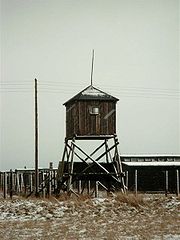
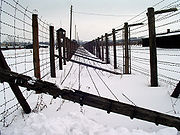
Canadian Jewish Congress
The Canadian Jewish Congress was one of the main lobby groups for the Jewish community in the country, although it often competed with the more conservative B'nai Brith Canada in that regard. At its dissolution, the president of the CJC was Mark Freiman. Its past co-presidents were Sylvain Abitbol...
, visited Majdanek on August 28, 1944. The following day he sent a telegram to Saul Hayes
Saul Hayes
Saul Hayes, OC was a Canadian lawyer and public servant in the Canadian Jewish community.Born in Montreal, Quebec, Hayes studied at McGill University where he received a Bachelor of Arts degree in 1927, a Master of Arts degree in 1928, and a Bachelor of Civil Law degree in 1932...
, the executive director of the Canadian Jewish Congress. It states: "I do wish [to] stress that Majdanek where one million Jews and half a million others [were] killed" and "You can tell America that at least three million [Polish] Jews [were] killed of whom at least a third were killed in Majdanek" though this estimate was never taken seriously by scholars.
In 1961, Raul Hilberg
Raul Hilberg
Raul Hilberg was an Austrian-born American political scientist and historian. He was widely considered to be the world's preeminent scholar of the Holocaust, and his three-volume, 1,273-page magnum opus, The Destruction of the European Jews, is regarded as a seminal study of the Nazi Final...
estimated the number of the Jewish victims at 50,000, though at the time other sources, including the camp museum, officially estimated 100,000 Jewish victims and up to 200,000 non-Jews killed.
In 1992, Czesław Rajca published a lower estimate of 235,000; it was displayed at the camp museum.
The 2005 research by the Head of Scientific Department at Majdanek Museum, historian Tomasz Kranz indicates that there were 79,000 victims, 59,000 of whom were Jews.
The differences in estimates stem from different methods used for estimating and the amounts of evidence available to the researchers. The Soviet figures relied on the most crude methodology, also used to make early Auschwitz estimates—it was assumed that the number of victims more or less corresponded to the crematoria capacities. Later researchers tried to take much more evidence into account, using records of deportations and population censuses, as well as the Nazis' own records. Hilberg's 1961 estimate, using these records, aligns closely with Kranz's report.
Notable inmates
- Halina BirenbaumHalina BirenbaumHalina Birenbaum is a Holocaust survivor, writer, poet and translator. Born in Warsaw, Birenbaum spent her childhood in the Warsaw Ghetto and later on in Nazi concentration camps: Majdanek, Auschwitz , Ravensbrück and Neustadt-Glewe, from which she was liberated in 1945...
- writer, poet and translator - Marian FilarMarian FilarMarian Filar was a Polish concert pianist and virtuoso.-Early life:Filar began to study piano at the age of five, and a year or so later he gave his first recital at the Warsaw Conservatory as a wunderkind. When 12 years of age, he played Mozart's Concerto in D Minor with the Warsaw Philharmonic...
- pianist - Otto FreundlichOtto FreundlichOtto Freundlich was a German painter and sculptor of Jewish origin and one of the first generation of abstract artists.-Life:...
- one of the artists included in the Nazis' 1937 "Degenerate ArtDegenerate artDegenerate art is the English translation of the German entartete Kunst, a term adopted by the Nazi regime in Germany to describe virtually all modern art. Such art was banned on the grounds that it was un-German or Jewish Bolshevist in nature, and those identified as degenerate artists were...
" exhibition - Israel GutmanIsrael GutmanIsrael Gutman is a Polish-born Israeli historian of the Holocaust.Israel Gutman was born in Warsaw, Poland. After playing an important role in the Warsaw Ghetto uprising, he was deported to the Majdanek, Auschwitz and Mauthausen concentration camps. His older sister died in the ghetto. After...
- historian - Henio ZytomirskiHenio ZytomirskiHenio Zytomirski , was a Polish Jew born in Lublin, Poland and was murdered at the age of 9 in a gas chamber in Majdanek concentration camp, during the Nazi occupation of Poland. Henio became an icon of the Holocaust, not only in Lublin but all over Poland...
- child becoming an icon of the Holocaust in Poland. - Dmitry KarbyshevDmitry KarbyshevDmitry Mikhaylovich Karbyshev was a Red Army general and Hero of the Soviet Union .-Early years:...
- Soviet general, Hero of the Soviet UnionHero of the Soviet UnionThe title Hero of the Soviet Union was the highest distinction in the Soviet Union, awarded personally or collectively for heroic feats in service to the Soviet state and society.-Overview:... - Omelyan KovchOmelyan KovchBlessed Оmelyan Kovch was a Ukrainian Greek-Catholic priest murdered in Majdanek concentration camp....
- Ukrainian priest - Igor NewerlyIgor NewerlyIgor Newerly or Igor Abramow-Newerly was a Polish novelist and educator. He was born into a Russian-Polish family. His son is Polish novelist Jarosław Abramow-Newerly...
- writer - Vladek Spiegelman, whose story is the basis for Art SpiegelmanArt SpiegelmanArt Spiegelman is an American comics artist, editor, and advocate for the medium of comics, best known for his Pulitzer Prize-winning comic book memoir, Maus. His works are published with his name in lowercase: art spiegelman.-Biography:Spiegelman was born in Stockholm, Sweden, to Polish Jews...
's MausMausMaus: A Survivor's Tale, by Art Spiegelman, is a biography of the author's father, Vladek Spiegelman, a Polish Jew and Holocaust survivor. It alternates between descriptions of Vladek's life in Poland before and during the Second World War and Vladek's later life in the Rego Park neighborhood of...
. - Rudolf VrbaRudolf VrbaRudolf "Rudi" Vrba, born Walter Rosenberg was a Slovak-Canadian professor of pharmacology at the University of British Columbia, who came to public attention during the Second World War when, in April 1944, he escaped from the Auschwitz concentration camp in German-occupied Poland with the first...
- transferred to Auschwitz, from which he escaped, and about which he co-authored the Vrba-Wetzler reportVrba-Wetzler reportThe Vrba-Wetzler report, also known as the Vrba-Wetzler statement, the Auschwitz Protocols, and the Auschwitz notebook, is a 32-page document about the German Auschwitz concentration camp in occupied Poland during the Holocaust...
, one of the first inside reports of the camp, and published during wartime. - Mietek GrocherMietek GrocherMietek Grocher is a Polish Jewish author and speaker who survived The Holocaust. Grocher recounts the events in his 1996 book Jag överlevde ....
- Survived nine different camps. Now a lecturer residing in VästeråsVästeråsVästerås is a city in central Sweden, located on the shore of Lake Mälaren in the province Västmanland, some 100 km west of Stockholm...
, SwedenSwedenSweden , officially the Kingdom of Sweden , is a Nordic country on the Scandinavian Peninsula in Northern Europe. Sweden borders with Norway and Finland and is connected to Denmark by a bridge-tunnel across the Öresund....
. Author of Jag överlevde (eng. I Survived). - Maryla Husyt Finkelstein - Late mother of the author and Middle East critic Dr Norman FinkelsteinNorman FinkelsteinNorman Gary Finkelstein is an American political scientist, activist and author. His primary fields of research are the Israeli-Palestinian conflict and the politics of the Holocaust. He is a graduate of Binghamton University and received his Ph.D in Political Science from Princeton University...
.
See also
- List of Nazi-German concentration camps
- Kaiser Wilhelm Institute of Anthropology, Human Heredity, and EugenicsKaiser Wilhelm Institute of Anthropology, Human Heredity, and EugenicsThe Kaiser Wilhelm Institute of Anthropology, Human Heredity, and Eugenics was founded in 1927. The Rockefeller Foundation supported both the Kaiser Wilhelm Institute of Psychiatry and the Kaiser Wilhelm Institute of Anthropology, Human Heredity and Eugenics...
- Research Materials: Max Planck Society ArchiveResearch Materials: Max Planck Society ArchiveAt the end of World War II, the Kaiser Wilhelm Society was renamed the Max Planck Society, and the institutes associated with the Kaiser Wilhelm Society were renamed "Max Planck" institutes. The records that were archived under the former Kaiser Wilhelm Society and its institutes were placed in the...
- Shark Island, German South West Africa

